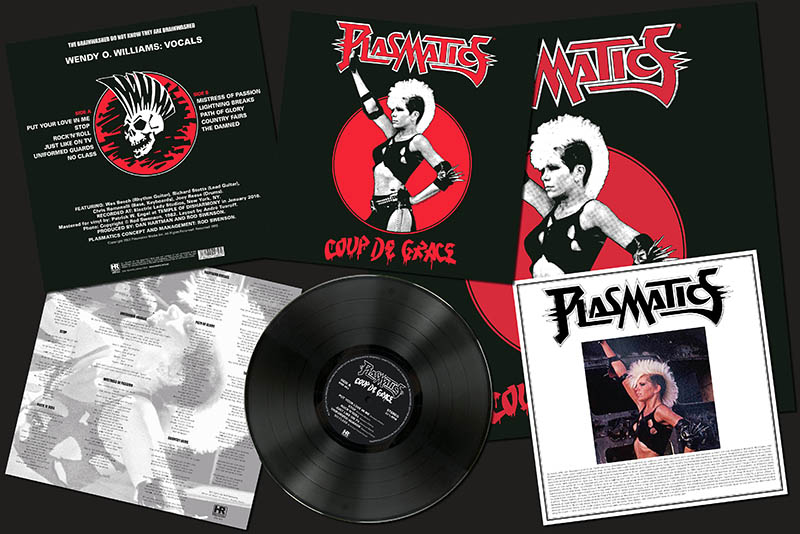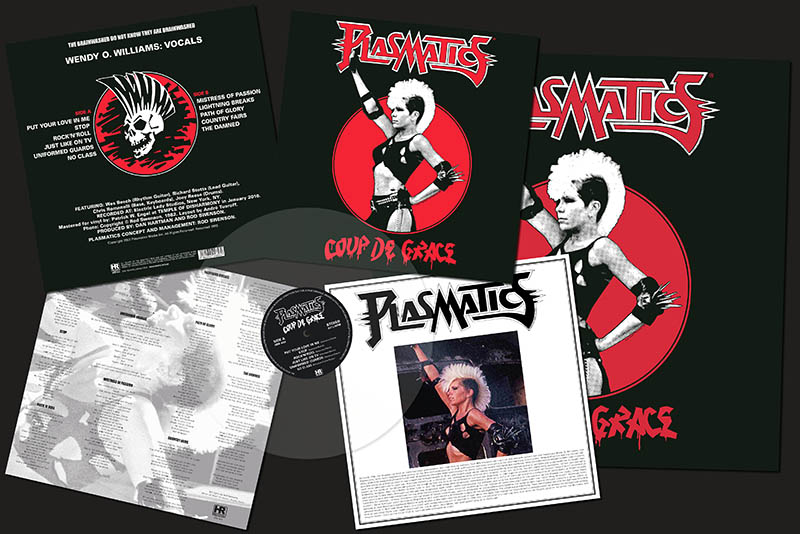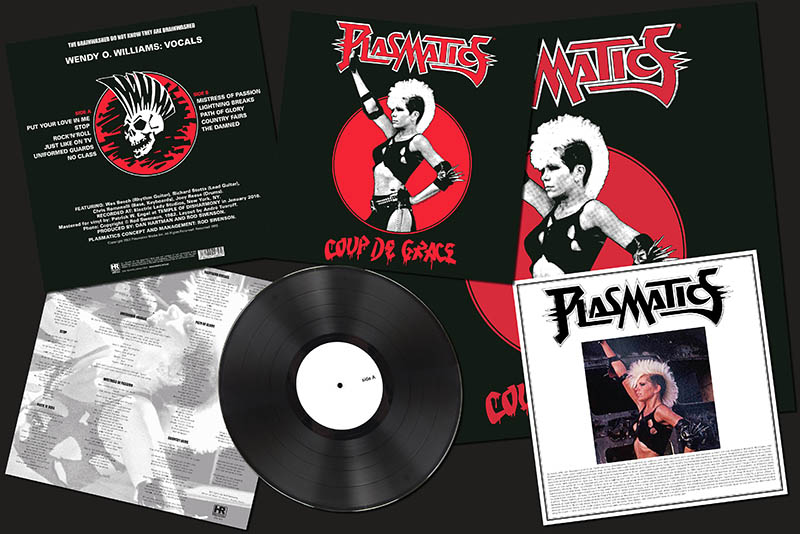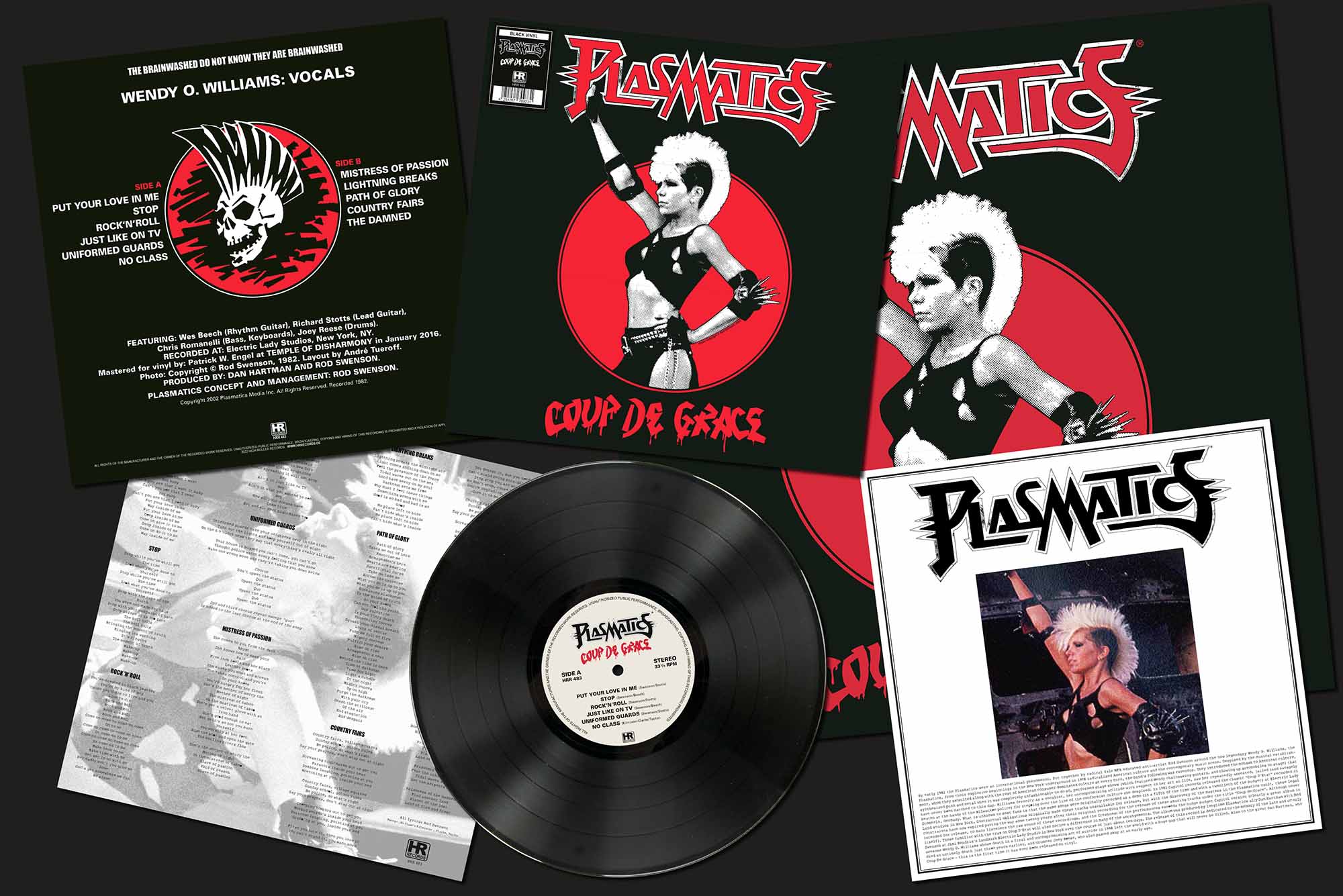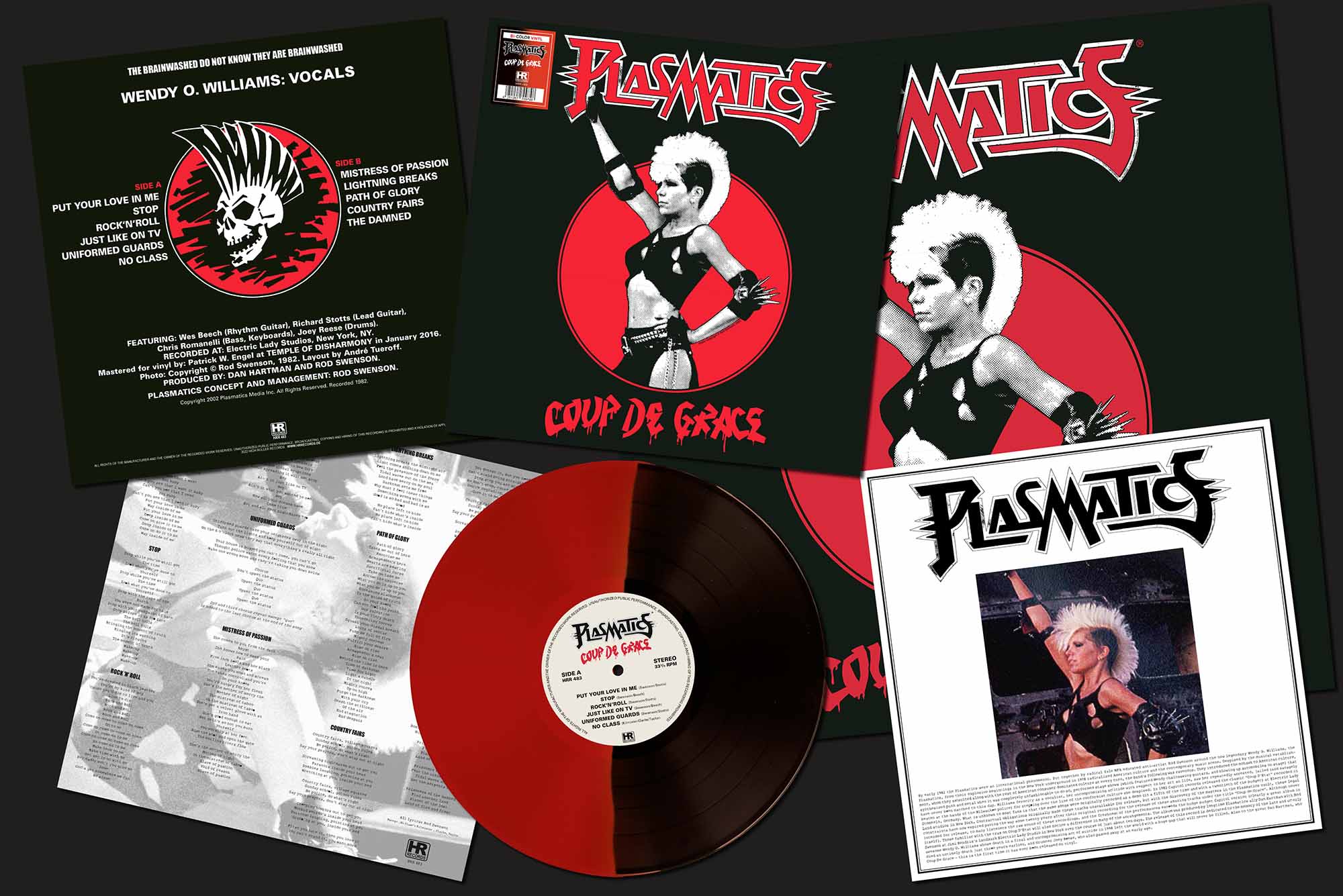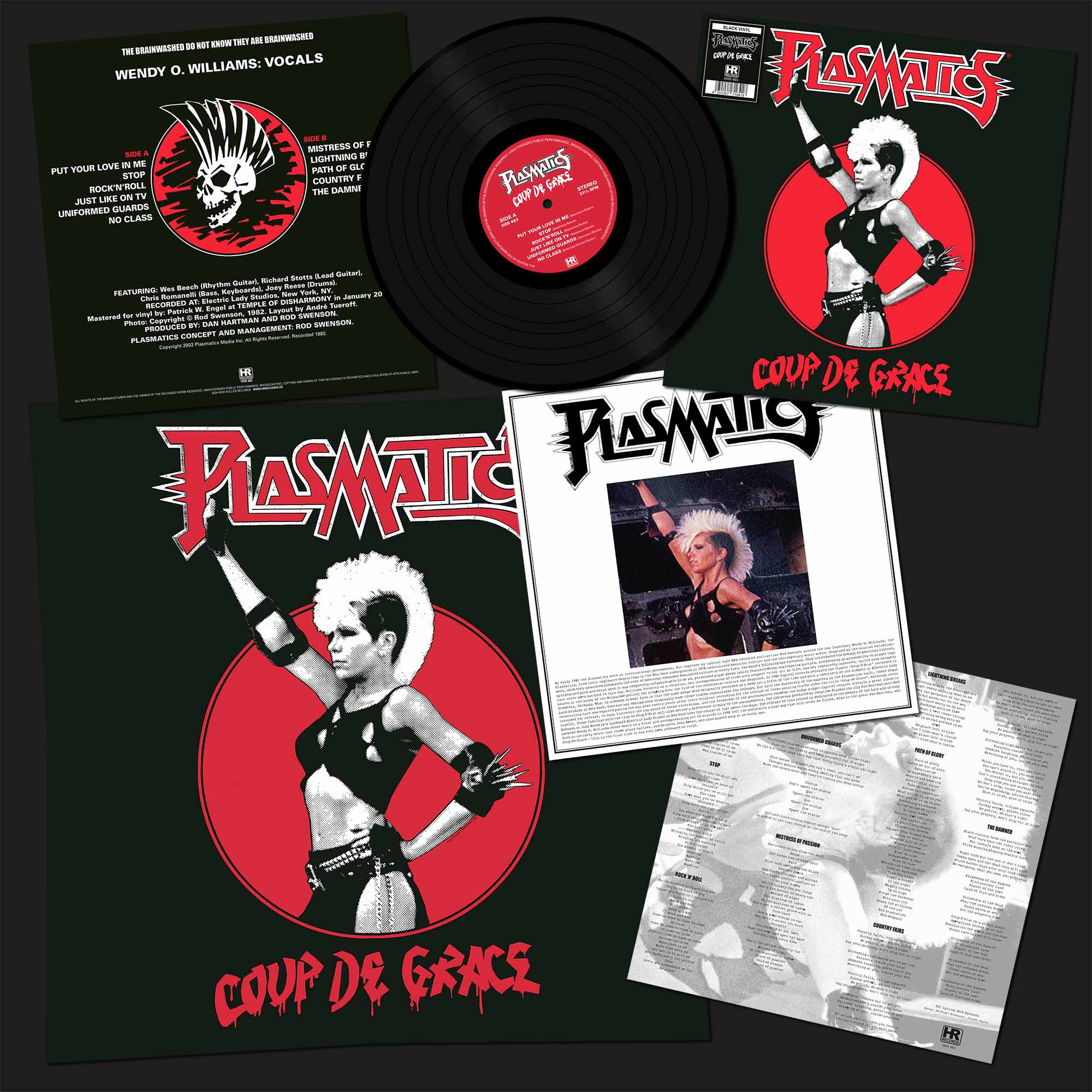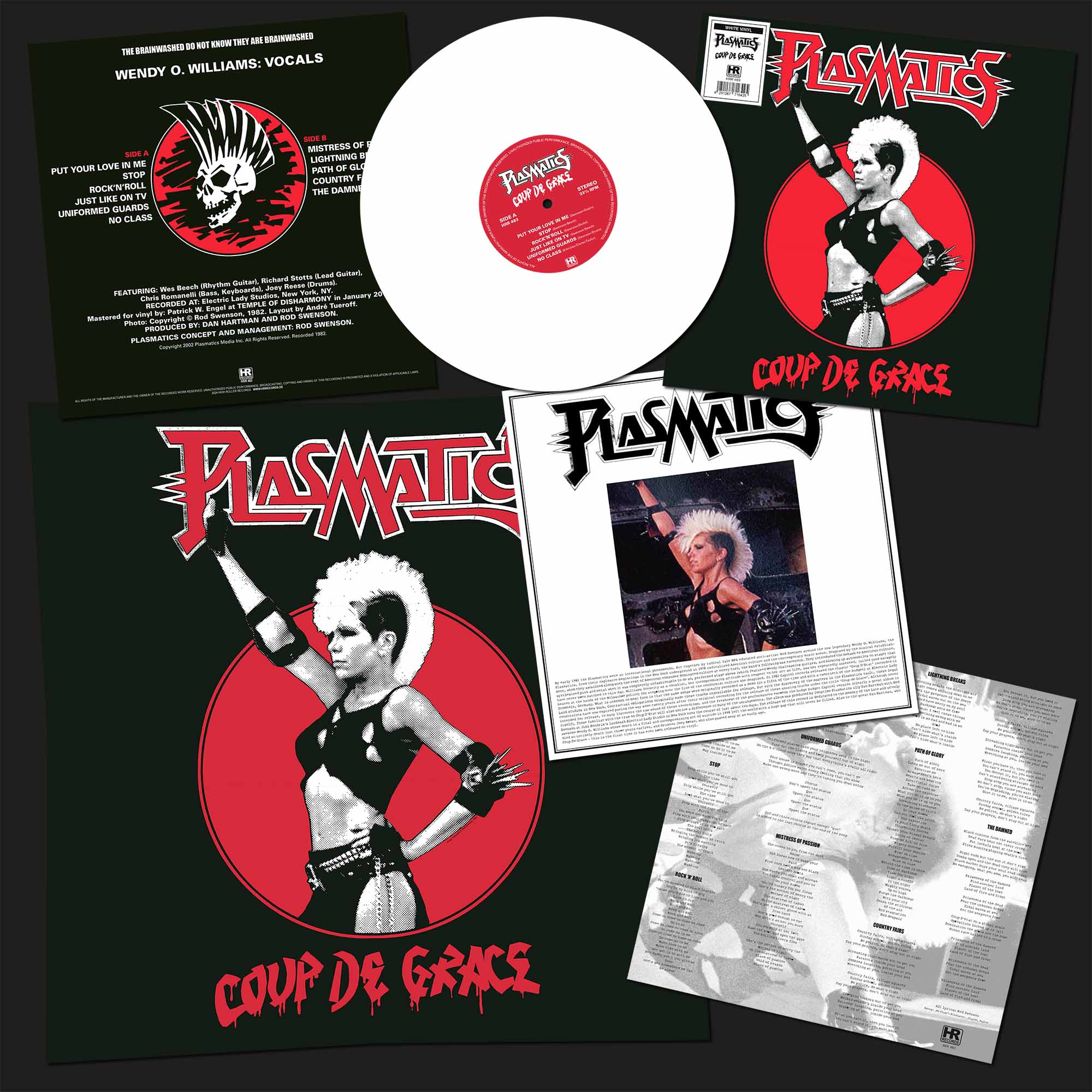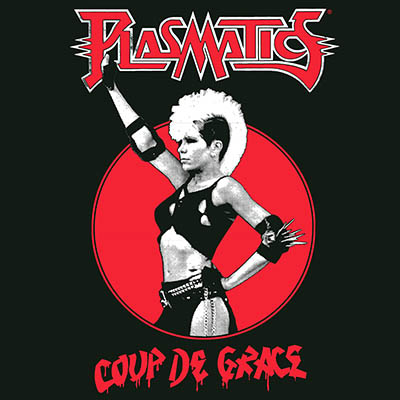 | ||||
| PLASMATICS - Coup de Grace LP | |
HRR 483LP, ltd 500, 200 x black, 200 x transparent blood-red + 100 x transparent ultra clear (HRR mailorder), 425gsm heavy cardboard cover, lyric sheet, poster, 2nd pressing: ltd 500, 200 x black, 150 x red w/ black & white splatter + 150 x black/ red bi-color split vinyl, 2nd pressing: ltd 500, 200 x black, 150 x black/ red bi-color + 150 x red/ white/ black splatter vinyl, insert, poster, 3rd pressing: 300 x black + 200 x white vinyl, insert, poster, 350g cardboard cover | |
| Wendy O. Williams - vocals Wes Beech - rhythm guitar Richard Stotts - lead guitar Chris Romanelli - bass, keyboards Joey Reese - drums | |
| -Put Your Love in Me -Stop -Rock 'n' Roll -Just Like on TV -Uniformed Guards -No Class -Mistress of Passion -Lightning Breaks -Path of Glory -Country Fairs -The Damned | |
| 1st+2nd pressing SOLD OUT! 3rd pressing: AVAILABLE | |
Mastered for vinyl by Patrick W. Engel at TEMPLE OF DISHARMONY in January 2016
The Plasmatics (managed by a certain Rod Swenson) were a legend in their own right. Formed in the late 1970s by guitarists Wes Beech and Richard Stotts, drummer Stu Deutsch, bassist Chosei Funahara and fronted by former porno actress Wendy Orleans Williams, the band was never really fully accepted by the original punk rock and hardcore scene in their native New York City. The Plasmatics soon signed to legendary English punk label Stiff Records (responsible for the first Motörhead 7” single) and issued their ground breaking debut album »New Hope For The Wretched« in 1980. Their sensational live shows, featuring blowing up a Mercedes car on stage and sawing guitars in half, were banned in a lot of places (like the Hammersmith Odeon in London) but did not fail to gain the Plasmatics a fanatical following mainly in continental Europe.
For a lot of fans and journalists the 1982 album »Coup D’État« (for which the band had signed to major label Capitol Records) marks the Plasmatics’ finest moment in their recording career. Recorded with the help of legendary German producer Dieter Dierks, »Coup D’État« is hailed as maybe the first true blue hardcore punk/metal crossover album in rock history! Featuring songs like “The Damned”, “Just Like On TV”, “Mistress Of Taboo” as well as a fantastic cover version of Motörhead’s “No Class”, »Coup D’État« paved the way for Wendy O. Williams’ later solo career under the W.O.W. banner.
However, not a lot of people know that there had been a slightly earlier attempt at recording the material in the band’s native New York. Those recordings (at Electric Lady Studios) later became known under the title of »Coup De Grace«. “The actual »Coup De Grace« recordings are very rough,” comments Gene of Plasmatics Media. “The whole thing was recorded in less than a week and then mixed in the same amount of time. »Coup D’État«, on the other hand, took almost three months plus a month of pre-production. So some of the tracks on »Coup De Grace« have a feel some people think that is kind of cool and missing on the later heavily produced version. The budget was something specifically I never heard manager Rod Swenson mention but it was miniscule by comparison.”
Comparing »Coup D’État« with the original recordings of »Coup De Grace«, some people have indeed stressed that the Dierks takes were missing the raw punk energy of the early Plasmatics and sounded a bit “overproduced”, if you will... “This is a very interesting perception,” states Gene, “and it is one I have not heard except internally and yes, great production in its way by Dieter Dierks, but many thought possibly ‘overproduced’, as you say. Dieter came and had the band performing to a metronome (Wes Beech discusses this on the Plasmatics history DVD) and everything was done over and over again. So some people thought that it would have been better a bit more raw. But to Dierks’ credit it should be said that Dieter gave it a lot of power with this precision.”
So why did Capitol not work with the »Coup De Grace« tapes in the first place? Were they just demos in Capitol’s eyes, or some kind of pre-production? Gene gladly gives us the whole story: “This was never intended to be the album. Wendy and Rod and everyone liked Dan Hartman (of Edgar Winter fame etc. and later the comeback of James Brown) a lot after doing »Metal Priestess« with him (it was done by Dan Hartman with Rod Swenson). And he wanted to produce the Capitol album, so the tracks were done as a demo principally for Capitol. Wendy and the band had already been signed but the album producer had to be picked and Capitol, because of the money they were putting in, wanted to pick or at least approve pick. So these were done as a demo. In the end Dieter also wanted to produce and he was coming off the huge Scorpions hit album and Capitol thought that would be better. The tapes themselves were done though as a demo (different drummer too, who was replaced for health problems shortly after the album was made and drummer TC who would go on to play on next four albums came in).”
With "Uniformed Guards" »Coup De Grace« features a song which did not end up on the final Dierks produced »Coup D’État«. Why was that? Gene: “This was the last album for the original lead guitarist Richie Stotts, who was very theatrical and did kind of noise leads while player Wes Beech did the cover work. But the level of the music here was beyond his style and he could not meet Dieter’s stringent demands and so Wes ended up having to do most of his rhythm parts while he worked on leads. But the time got way beyond budget and so ‘Uniformed Guards’ had to be dropped simply because there was not enough time to finish it.”
One of the key songs on the album is "The Damned", for which a video was shot as well. Gene explains: “Yes, this was the clip where Rod came up with this scenario with Wendy jumping from the top of a moving bus after going through a wall of TVs and the bus blows up. Scared Capitol and MTV both. Yes, a great song. Rod (who wrote all the lyrics of the songs over the years) had actually written most of the lyrics to ‘The Damned’ for another song that was never recorded called ‘Simian King’. But when he heard the riffs for what became ‘The Damned’, brought in by Chris Romanelli, he liked it so much he used them as the lyrics for that song which became ‘The Damned’.”
“The Damned” was later covered by German Thrash Metal band Destruction. In the form of "No Class" »Coup D’État« also featured a Motörhead cover, but Lemmy did not participate on the album, why didn't he? Wendy and him had recorded a single together a bit earlier (which resulted in the exodus of Fast Eddie from Motörhead...). “No, there never was any thought about having Lemmy participate in the album,” Gene is stating. “The recording of ‘Stand By Your Man’ was such a disaster that I don’t think at that time Wendy or Rod would have wanted to work with Lemmy again. The story of that recording is not what Motörhead released to the press (which Wendy and Rod didn’t actually hear until years later). Mostly involving the drugs and alcohol use by Motörhead that rendered Lemmy almost completely dysfunctional but beyond this discussion here. There were some collaborations later. Rod produced and directed Motörhead’s ‘Killed By Death’ video as a favour to their managment and some dates were arranged for the purpose of getting Wendy in front of new audiences, like any tour or appearance dates but I think the thought would have been the farthest from anyone’s mind. Also, remember Capitol was looking for big name producer and Lemmy at the time was hardly that.”
As mentioned earlier, »Coup D’État« was originally released in 1982. In my book it's one of the first true metal/punk/hardcore crossover albums. The Plasmatics just never got the credit they deserved for that. Even in N.Y.C.H.C. circles they were the odd band out... “Yes, you are absolutely right,” confirms Gene. “»Coup D’État« was a breakthrough album, very daring in that sense (you need to see Dante Bonutto’s discussion of this on the DVD »10 Years of...« and also Chris Knowles from Classic Rock also on that DVD). It was way ahead of its time. Got some high praise, but you’re right as far as real credit... or what would be proper credit or even sales that... and here is where I will tell you the main reason why it deserved it is because Wendy was a breakthrough performer in an almost all-male rock genre. People didn’t want to hear a woman that sounds tough etc. This was the main thing, an astoundingly sexist thing (some great discussion of this also on the DVD), daring but too daring for the mainstream.”
The role of manager Rod Swenson for the Plasmatics has often been compared to that of Malcolm McLaren regarding the Sex Pistols. Maybe an unfair assessment? “Well for us WOW/Plasmatics people we don’t think a whole lot of the Sex Pistols,” says Gene. “And of course they were around for what, an album or two, and a dismal tour (see Chris Knowles on the DVD who calls it a ‘joke’). But I know what you mean. I’m not sure exactly what Malcolm McLaren is now historically said to have done but it is not likely to have been as much as Rod, who likely is under not overinterpreted for his role. The Plasmatics were literally a creation of Rod Swenson. He created the name (which was originally Butcher Babies but when he wrote the lyrics to the song of that name, ‘Butcher Baby’, he changed the name to Plasmatics). It was built and created around Wendy and as a very specific assault as they used to say on the status quo (which included sexism or male dominated rock and roll or female ‘sing pretty’ music) etc. So Wendy was the stage, the performer side, and Rod was the eyes, ears, creation side. Rod wrote all the lyrics from day one for all the songs, shot the album covers, the latter done initially under pseudonyms (Stellar Axeman for the music/lyric part, and Butch Star for al the photography and videos etc.) to specifically take the spotlight off of him and put it on Wendy. The project was built as a vehicle for her. In addition, of course he did produce, story-board and direct all the over the top videos as well as designing and creating the staging (the car explosions and all that). He designed and laid out the posters, produced the advertising, both the newspaper ads and radio spots that show promoters around the U.S. were given to use as part of their kit. There was no ‘band’ as such, I think 17 different members over the whole ten year period with changes of personnel, roughly at least two per album, I think. In the earliest days, Rod also designed and physically ran the lighting during the shows although as the band grew, this was giving to a lighting director but he continued with design. There’s a lot of stuff in the staging (like airforce landing lights pointing at the audience) that became widely adopted that were, as far as I know, created by him. A lot of the other staging, too. During the ten year run his role was downplayed (which I think would be ‘underinterpreted’ if I have your phrasing) intentionally to make Wendy the star, and she was, a really one of a kind daring and OTT performer. The only band member that was really permanent was Wes Beech, who performed or worked on almost every WOW/Plasmatics record and was there from the early pre-»New Hope For The Wretched« days right through until the end.”
Matthias Mader
